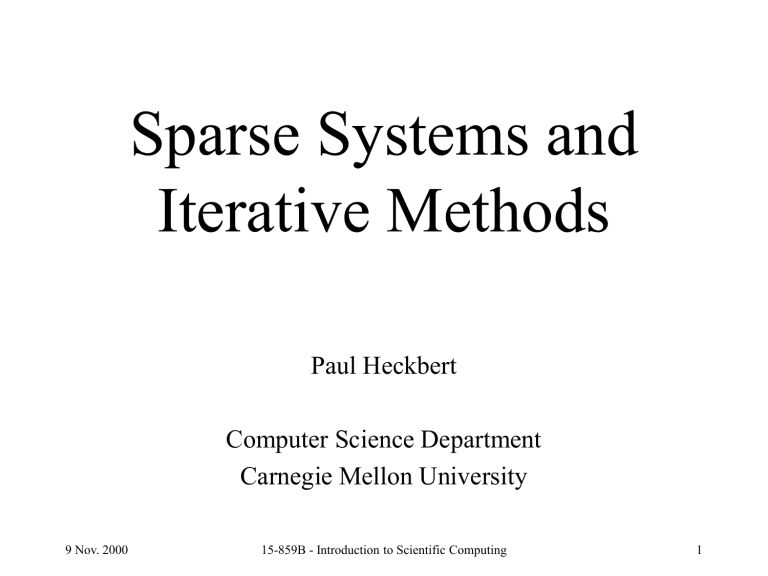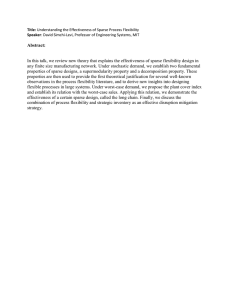Sparse Systems and Iterative Methods Paul Heckbert Computer Science Department

Sparse Systems and
Iterative Methods
9 Nov. 2000
Paul Heckbert
Computer Science Department
Carnegie Mellon University
15-859B - Introduction to Scientific Computing 1
PDE’s and Sparse Systems
• A system of equations is sparse when there are few nonzero coefficients, e.g. O( n ) nonzeros in an n x n matrix.
•
Partial Differential Equations generally yield sparse systems of equations.
• Integral Equations generally yield dense (non-sparse) systems of equations.
• Sparse systems come from other sources besides
PDE’s.
9 Nov. 2000 15-859B - Introduction to Scientific Computing 2
Example: PDE Yielding Sparse System
• Laplace’s Equation in 2-D:
2 u = u xx
– domain is unit square [0,1] 2
+ u yy
= 0
– value of function u ( x,y ) specified on boundary
– solve for u ( x,y ) in interior
9 Nov. 2000 15-859B - Introduction to Scientific Computing 3
Sparse Matrix Storage
• Brute force: store nxn array, O( n 2 ) memory
– but most of that is zeros – wasted space (and time)!
• Better: use data structure that stores only the nonzeros col 1 2 3 4 5 6 7 8 9 10...
val 0 1 0 0 1 -4 1 0 0 1...
16 bit integer indices: 2, 5, 6, 7,10
32 bit floats: 1, 1,-4, 1, 1
• Memory requirements, if kn nonzeros:
– brute force: 4 n 2 bytes, sparse data struc: 6 kn bytes
9 Nov. 2000 15-859B - Introduction to Scientific Computing 4
An Iterative Method: Gauss-Seidel
• System of equations Ax = b
• Solve ith equation for x i
:
• Pseudocode: until x stops changing for i = 1 to n x[i] (b[i]-sum{j i}{a[i,j]*x[j]})/a[i,i]
• modified x values are fed back in immediately
• converges if
A is symmetric positive definite
9 Nov. 2000 15-859B - Introduction to Scientific Computing 5
Variations on Gauss-Seidel
• Jacobi’s Method:
– Like Gauss-Seidel except two copies of x vector are kept,
“old” and “new”
– No feedback until a sweep through n rows is complete
– Half as fast as Gauss-Seidel, stricter convergence requirements
• Successive Overrelaxation (SOR)
– extrapolate between old x vector and new Gauss-Seidel x vector, typically by a factor
between 1 and 2.
– Faster than Gauss-Seidel.
9 Nov. 2000 15-859B - Introduction to Scientific Computing 6
Conjugate Gradient Method
• Generally for symmetric positive definite, only.
• Convert linear system
Ax=b
• into optimization problem: minimize x T Ax-x T b
– a parabolic bowl
• Like gradient descent
– but search in conjugate directions
– not in gradient direction, to avoid zigzag problem
• Big help when bowl is elongated (cond(
A ) large)
9 Nov. 2000 15-859B - Introduction to Scientific Computing 7
Conjugate Directions
9 Nov. 2000 15-859B - Introduction to Scientific Computing 8
Convergence of
Conjugate Gradient Method
• If
K = cond( A ) =
max
( A )/
min
( A )
• then conjugate gradient method converges linearly with coefficient (sqrt( K )-1)/(sqrt( K )+1) worst case.
• often does much better: without roundoff error, if A has m distinct eigenvalues, converges in m iterations!
9 Nov. 2000 15-859B - Introduction to Scientific Computing 9
